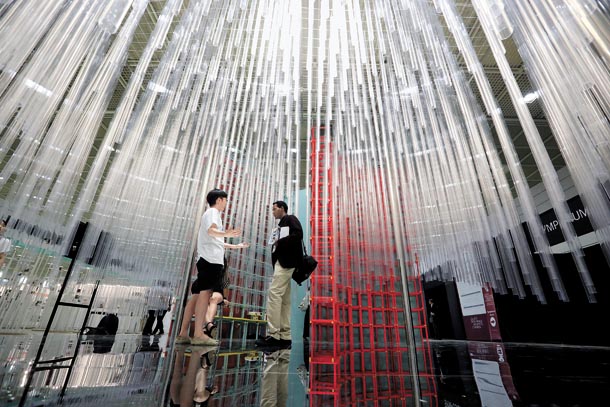Building a sustainable future for the world’s cities: Triennial gathering of UIA brings urban innovators to Seoul

Visitors look around an exhibit in the Student & Young Architect Platform at the International Union of Architects Congress being held at COEX in southern Seoul on Monday. [INR COMMUNICATIONS]
But now, the game has changed. Once focused on producing large-scale projects to get the biggest bang for the buck, contemporary architecture is all about culture, future and nature - the three mains themes of the UIA (International Union of Architects) 2017 Seoul World Architects Congress, which is being held until Thursday at COEX in southern Seoul. Following the congress, the organization’s General Assembly will be held at the Dongdaemun Design Plaza in central Seoul from Sept. 7 to 10.
It’s the first time so many architects from all over the world have gathered in Seoul, with an estimated number of over 30,000 people having applied for the program before it began. The UIA Congress, commonly dubbed “Architect’s Olympics,” does not simply offer a place for architects to gather and share the latest practices and technology, but a deeper appreciation of the role and potential of architecture in a better society.
“More than half the world’s population lives in cities, and that percentage [55 percent] will be 66 percent in 2050,” said Wilfried Wang, an architect at Hoidn Wang Partner in Berlin, Germany, at the event’s first keynote forum. The kickoff speaker set the agenda for the whole congress, the essence of which lies in sustainability. Wang suggested eight principles for socially sustainable cities, including involving the public, keeping as much of the existing fabric as possible and increasing public spaces.
While keynote speeches and seminars provide an architect’s insight into the present and future of urban design around the world, the exhibitions at the event, offer visitors a more visible experience. Rather than listening to the architects talk about sustainable design or the Mayor of Seoul, Park Won-soon, talk about creating a “people-oriented city,” people see for themselves how architecture will shape the next generation.
The exhibitions are divided into three sections: the UIA Plaza, the Architecture Fair and the Student & Young Architect Platform. The UIA Plaza is dedicated to the members of the UIA, displaying works by individual architects or regional organizations, such as the Union of Architects of Azerbaijan.
Architecture Fair, which takes up the majority of the space, introduces actual facilities, building methods, materials and other technical details developed by some 300 companies. One of the exhibits includes “Pleasurescape,” by renowned designer Karim Rashid, who is on display at the Seoul Arts Center, southern Seoul, until Oct. 7.

The UIA exhibition offers a visual explanation of modern architecture, including common practices and experiments. Left is a model of a city produced by the Union of Architects of Azerbaijan. At right is a modern interpretation of hanok, a traditional house in Korea, made by the Seoul Metropolitan Government. The exhibition closes at 6 p.m. on Wednesday and at 5 p.m. on Thursday. [YOON SO-YEON]
The congress wasn’t without its share of woes, however. Some delegations complained of miscommunication over the reservation of booths, which led to some arguments early on.
Despite the bickering over booths, and even some empty booths due to some teams failing to show up without prior notice, the congress has indeed aroused a sense of excitement for architecture here in Seoul.
It is no exaggeration to say that Seoul has transformed itself into a gigantic architecture museum for the month of September, in line for the triennial get-together of experts from the field.
From Tuesday to Saturday, the 2017 KIA (Korean Institute of Architects) Convention and Exhibition in Culture Station Seoul 284, central Seoul, opens its doors to the public to offer an overview of architecture in Korea. The 2017 Seoul Architecture Festival will be open until Sept. 24 at the newly opened Oil Tank Culture Park in western Seoul; the tank itself is an urban renewal project by the Seoul Metropolitan Government. Additionally, 2017 Architecture Day begins Wednesday at COEX, and the 2017 Seoul International Architecture Film Festival at the Seoul Museum of History, central Seoul, will run until Sept. 24.
As this year marks the first time Seoul has hosted such a vast array of architecture-related events at once, the capital city hopes to prove itself as a global leader of design and urban innovation.
BY YOON SO-YEON [yoon.soyeon@joongang.co.kr]
To go to COEX, get off at Samseong station, line No. 2, exit 5. For more information, visit www.uia2017seoul.org or call (02) 6288-6349. A smartphone app is available at the following address: http://guidebook.com/app/uia2017/










with the Korea JoongAng Daily
To write comments, please log in to one of the accounts.
Standards Board Policy (0/250자)